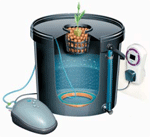The term hydroponics was originally coined in the mid 20th Century. It is a term used to express a technique for growing plants in a soil less medium. The concept of growing plants without soil goes way back in time to our prehistoric past. For example, the mythical Hanging Gardens of Babylon, the much worshipped flooding of the Egyptian Nile and the Floating Gardens of Mexico City are all examples of hydroponics. History, as it always seems to do, has turned full circle and the rebirth of hydroponics is back with us. Approximately 90% of all cut fresh flowers purchased in the UK are hydroponically grown, and an estimated 65% of all fruit and vegetables purchased from your supermarket, again are grown in hydroponics systems under HPS grow lights.
Plants are grown in an inert, sterile growing medium and fed a mixture of water and nutrient. The principle is basic; plants that are grown in soil have to continuously develop their rootballs in search of water, nutrients and air so the majority of the plants available energy is spent on the lower root development restricting its upper growth. In hydroponics, the water, nutrient and air is mainlined directly to the rootball, freeing the plant to use its available energy in its upper leaf, fruit, or flower development. That coupled with the fact that it has all the specific nutrient, air and water it could ever want, means plants grow at a previously unheard of rate. If you like "it's super charged battery farming for plants on steroids" but the plants are in heaven, not hell. Because plants grown in a hydroponics system can be given very exact and specific doses of nutrient, a crop raised hydroponically will develop optimum levels of appearance, yield and flavour. Because the roots of plants grown in a soil less medium do not need to constantly grow in search of nutrient, more plants can be grown in a smaller area. You will thus be making the best use of whatever space is available to you.
|
|
In short, hydroponics allows you to grow approximately twice to ten times the yield, in half the space and in half the time. So, if you have a greenhouse, conservatory, spare room, loft, cellar, or closet, you too can become hydroponically enlightened.
There are few experiences more rewarding than cultivating crops; possibly mankind's oldest vocation. Experienced growers know what it is like to participate in the life cycle of plants, to create, to nurture, to encourage and to stimulate a crop to fulfil its potential.
A wise shaman once said - man's survival depends on three things; the merging of Technology and Nature, Science and Religion and Dance and Idea. The trinity is now with us; let us embrace it. The hydroponic experience will bring new meaning into your life, one that is mystical, enlightening, educational, satisfying and fun.
Daily excerpt from Hydroponicist - Indoor Horticulture:
This is the simplest method of hydroponics and is used mainly by growers who only wish to cultivate a minimal number
of plants. It is a true domestic incarnation of hydroculture. This technique
is cheap and works well, however, is high maintenance and not very easy
to manage. The system consists of a bucket with a lid, large net pot,
clay pebbles, large air pump, airline, and a large round air stone.
and is used mainly by growers who only wish to cultivate a minimal number
of plants. It is a true domestic incarnation of hydroculture. This technique
is cheap and works well, however, is high maintenance and not very easy
to manage. The system consists of a bucket with a lid, large net pot,
clay pebbles, large air pump, airline, and a large round air stone.
Purchase the hydroponics book at hydroponicist.com
|
|

